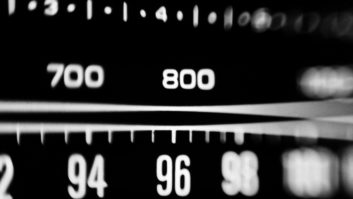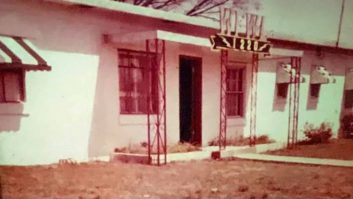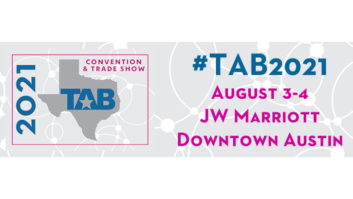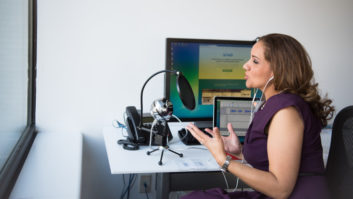Radio World would like to hear your first-person recollections about early or unusual radio remote broadcasting. To get the conversation started, we asked three radio veterans to share a few anecdotes about the Good Ol’ Days of Radio Remotes. E-mail yours to[email protected].
George Marti

George Marti Perhaps the most familiar name associated with remotes is that of George Marti.
After serving in World War II at the Naval Research Lab in Washington and later in the Pacific, where he was in charge of communications for a Marine air group, the 25-year-old was discharged in 1945. A trained radio engineer since 1937, Marti naturally returned to broadcasting.
In 1947, he and his wife Jo began building an AM station, KCLE(AM) in Cleburne, Texas (where he built the 250-watt transmitter and audio console in his mother’s living room).
“KCLE was 28 miles south of Fort Worth,” Marti says. “I got the AM station to air but then ran into a problem: We wanted to do remote broadcasts, but there were no telephone lines linking many of the areas we wanted to cover.”
To solve the matter, Marti also built a remote program unit, or RPU.
“This was a small portable transmitter that you took to the remote broadcast location,” he said. “You then broadcast the remote over VHF directly back to an antenna on the station tower. With the receive antenna I put on KCLE’s 300-foot tower, we could do remotes anywhere within a 25- to 30-mile radius.”
The first RPU was about 12 inches high, 14 inches wide and 8 inches deep; it had a handle on top to allow for easy carrying. The success of Marti’s first RPU led him to build a second, then another and then another. Eventually, so many people were asking him to build RPUs that he established Marti Electronics in 1960 to design and build RPUs. It expanded later into STL manufacturing.
“I got so involved in making these devices that I ended up building them full-time until I retired in 1996 and sold the company to Broadcast Electronics,” Marti says.
Despite the proliferation of other means of moving audio, the Marti RPU — often affectionately called simply “the Marti” — is still used in many places to connect remote broadcast sites wirelessly.
The Texas Association of Broadcasters recently presented its Lifetime Achievement Award to George Marti, just the latest honor in a celebrated engineering career. He is 90.
Vern Kaspar
The president and CEO of Kaspar Broadcasting Co., which owns stations in Missouri, is Vern Kaspar. He has radio roots back to the 1930s, a time when “every radio station had to have a radiotelephone operator’s license. Back then, smaller stations had to get their news by Morse Code, because we didn’t have access to teletype. So you needed someone on duty who could copy Morse Code accurately.”
In the 1940s, Kaspar was a radio engineer assigned to setting up concert and church remote broadcasts.
“I used to be sent out to cover Glenn Miller, Kay Kyser and Harry James when they came to town,” he recalls. “I was the guy who set up the tube amplifier, which was connected to a microphone on stage to capture the broadcast. It was a great job, especially if you had a date. The security people would wave you through the line, you’d get to say a few words to the band’s conductor. It made me feel like a big shot.”
Tube amplifiers were the workhorse of radio remotes. Whether installed in trucks or in more portable steel boxes, these units captured the audio, then boosted it for transmission via telephone line back to the station’s console, which may have had a dedicated input for remote broadcasts.
“We didn’t worry about audio quality and frequency response in those days,” Kaspar says. “We were just happy to hear live audio from around the listening area, especially if it was a big band.”
Where life got difficult was in dealing with the telephone company: Radio remote engineers never knew when they might get disconnected by someone doing work at the Central Office.
“Easter sunrise services were the most frustrating, because you’d get all set up to go and then find your telephone line didn’t work — and there was no one you could call to get help,” he says. “Or you would be covering a ball game away from home, and suddenly someone at the phone company would drop your line simply because they weren’t watching what they were doing. That was just the risk of doing things by telephone line back then, and it could drive you crazy.”

Charles Holland Charles Holland
For the past 60 years, Charles Holland has been a radio engineer. Even today, in his mid-80s, he serves as chief engineer for Thunderbolt Broadcasting’s KYTN and WQAK in Union City, Tenn.
One of the radio remote highlights of Holland’s career was covering a live speech by President Harry Truman in the 1940s.
“Back then, you just walked into the venue, set up your equipment and did a sound check without any problem,” Holland says. “You did introduce yourself to the Secret Service, but that was about it.”
Charles Holland relied on a portable tube amplifier and telephone lines to get the president’s live audio out to his clients, in this case, a seven-station ad hoc network. The broadcast went without a hitch.
Such wasn’t the case for a live Army big band concert.
“I got to the site and discovered that the phone wire had been pulled up onto the pole, 30 feet off the ground,” Holland recalls. “I went to the person who was managing the remote and said, ‘Chief, I can’t connect to the phone wire. I don’t have a ladder.’ He replied, ‘Just take my amplifier wire and run it out the window,’ which I did.
“So it looks like we’re connected to cover the remote, but we aren’t. Instead, as the band plays, someone back at the station played their music from a record.”
Did this ruse work?
“Thanks to the way it was handled back at the station, no one knew the difference,” Holland said with a laugh. “It was the radio remote that wasn’t.”












